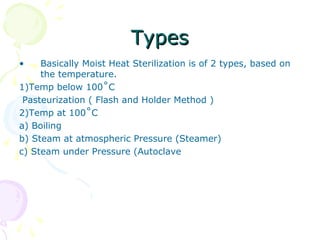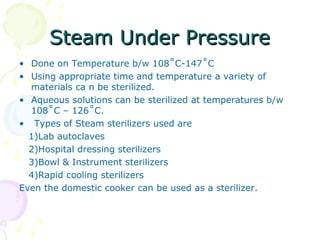Describe the Three Most Common Methods of Heat Sterilization
They are used mainly in situ of thermoplastic materials instead of thermosetting ones because of the fact that they will be remolded into the specific shape and size whether or not after cooling and settling down. Engineering plastics are a bunch of plastics that are used most ordinarily in industries because of their enhanced mechanical and thermal properties.

Moist Heat Sterilization A Review
Organic synthetic fibers such as aramid an aromatic polyamide with the commercial name Kevlar offer greater strength and stiffness than glass fibers but these synthetic fibers are considerably more expensive.

. The most common cabinet is the Class II Type A2 biosafety cabinet. General Considerations Due to the emphasis on microorganisms in water quality standards and enforcement activities and their continuing role in research process control and compliance monitoring laboratories need to implement document and effectively operate a quality management system QS for microbiological analyses. Heat is by far the most commonly used method of food preservation.
The charge of an electron is considered to be negative by convention and this charge is equal and opposite to the charge of a proton which is considered to be positive by conventionThe net charge of an ion is not zero because its total number of electrons is unequal to its total number of protons. Dental professionals most commonly use the. If your environment was different then there is a chance that you would not have grown.
GUIDE 1 TO INSPECTIONS OF ASPECTIC PROCESSING AND PACKAGING FOR THE FOOD INDUSTRY. Typically dry heat filtration and steam sterilization are used with compounded preparation. An ion ˈ aɪ ɒ n-ən is an atom or molecule with a net electrical charge.
A biosafety cabinet provides three layers of protection. Disposable or autoclavable loopsspreaders are available to replace flame sterilization of metal loops or metalglass plate spreaders. There are various degrees of preservation by heating that ultimately dictate the type of f inal.
In order for you to grow certain requirements had to be met. Figure 136 a Sterilizing a loop often referred to as flaming a loop is a common component of aseptic technique in the microbiology laboratory and is used to incinerate any microorganisms on the loop. Sterilization - validation qualification requirements Dawn Tavalsky 2 Sterilization - Overview Objectives Discuss definition of Sterile Briefly describe sterilization methods Describe approaches to be used for the validation of a sterilization process using Moist Heat as an example Describe requirements for routine monitoring.
There are several types of sterilization but the most appropriate method will depend on the physical and chemical properties of the preparation and its packaging. Sewage treatment or domestic wastewater treatment municipal wastewater treatment is a type of wastewater treatment which aims to remove contaminants from sewage to produce an effluent that is suitable for discharge to the surrounding environment or an intended reuse application thereby preventing water pollution from raw sewage discharges. 1 This document is reference materials for investigators and other FDA personnel.
Due to a combination of strength and affordability glass fibers which are woven ٢٣ into the product are the most common reinforcing material. The Journal of Endodontics the official journal of the American Association of Endodontists publishes scientific articles case reports and comparison studies evaluating materials and methods of pulp conservation and endodontic treatmentEndodontists and general dentists can learn about new concepts in root canal treatment and the latest advances in. The QS establishes an.
The most popular methods for the isolation and cultivation of fi lamentous fungi for various purposes with the emphasis on enzyme production and molecular microbiology. 211 Methods of sterilization that can be used for critical or semicritical dental instruments and materials that are heat-stable include steam under pressure autoclave chemical formaldehyde vapor and dry heat eg 320 º F for 2 hours. However moist-heat sterilization is typically the more effective protocol because it penetrates cells better than dry heat does.

Comments
Post a Comment